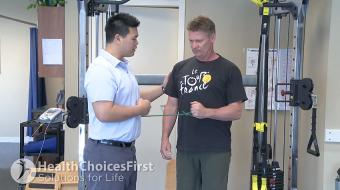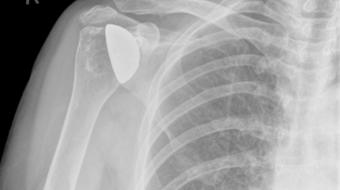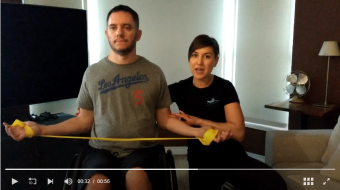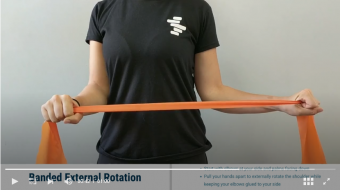Featured Videos
All Videos
The shoulder is the most mobile joint in the body, and is prone to a number of injuries, from shoulder dislocation to rotator cuff issues. The usual treatment for shoulder injuries is non-surgical options such as medications, bracing and physiotherapy. Shoulder surgery is generally only explored if the non-operative options fail, and the type the orthopaedic surgeon performs depends on the severity of your issue. Whether your shoulder injury treatment or surgical or non-surgical, you can benefit from the help of a physiotherapist during your recovery.
Physiotherapy for Shoulder Injuries
Usually, your physiotherapist will start you off with exercises to improve your range of motion and strengthen your arm and shoulder. If you’ve been hospitalized for shoulder surgery, your physiotherapy treatment may begin in the hospital, and continue once you’re home.
Types of Physiotherapy for Shoulder Injuries
• Range of motion and strengthening exercises targeting a range of muscles including the deltoids, trapezius muscles, biceps, triceps, supraspinatus and infraspinatus
• Manual therapy (hands-on manipulation)
• Ultrasound: This deep heating treatment is administered by your physical therapist using a wand that’s connected to an ultrasound machine pressed against your skin.
• Dry needling and/or acupuncture: Some patients find relief from a practitioner inserting short, thin needles into pressure points.
• TENS (transcutaneous electrical nerve stimulation): Your physiotherapist may use this technique to decrease pain around the injury.
• Taping: Your physiotherapist may tape the injured site to provide support and stability while you heal.
• Heat therapy: The physiotherapist may incorporate heat into your treatment to reduce pain, increase circulation and relax the muscles.
• Massage and other soft tissue techniques
Your physiotherapist can help you avoid activities and exercises that trigger pain and discomfort. Helping you regain functional use of your arm and shoulder is the primary goal of your physiotherapist. The sooner you see out a physiotherapist for treatment after an injury or surgery, the better your outcome will be.
Print this Action Plan and check off items that you want to discuss with your healthcare provider
-
Usually, your physiotherapist will start you off with exercises to improve your range of motion and strengthen your arm and shoulder. If you’ve been hospitalized for shoulder surgery, your physiotherapy treatment may begin in the hospital, and continue once you’re home.
-
Depending on your injury, your physiotherapist will recommend treatments such as ultrasound, dry needling/acupuncture, taping, TENS, heat therapy and massage.
-
You'll do range of motion and strengthening exercises, combined with manual therapy (hands-on manipulation) with your physiotherapist.
-
The sooner you see out a physiotherapist for treatment after an injury or surgery, the better your outcome will be.
-
One of the most common causes of elbow pain is repetitive strain or overuse of the muscles of the forearm. Eventually, the muscle and tendon can become overloaded and result in pain or weakness with any hand movements.
Adherence:
Adhering to your medications, prescribed exercises or lifestyle changes (such as dietary changes, smoking cessation, reduced alcohol consumption, etc.) is essential to improving health outcomes successfully. Compliance to any prescribed treatment is the number one thing you can do to ensure positive changes and optimal treatment outcomes.
Handout Shoulder Surgery - Post Operative Information
For patients that have currently undergone an orthopaedic shoulder surgery it is important to follow key instructions from your Orthopeadic Surgeon carefully. To help you in your recovery, the following is a list of commonly asked questions and answers.
- How long do I keep the bandages on after surgery? ANSWER: 3 - 4 days
- Can I shower after surgery? ANSWER: Yes, you may shower as long as you keep the wounds dry. After 7-10 days when the wounds are healed you can then shower without worrying about keeping the wounds dry.
- Should I put ice on the joint after surgery? ANSWER: Yes, you should ice the affected joint regularly, 10 -15 minutes on and then off. You may re-apply the ice once the skin returns to room temperature.
- Should I wear a sling after surgery? ANSWER: Yes, you should wear a sling to protect the shoulder from sudden movements or falling. It should be worn most of the time if there is a risk to the shoulder. If you are in a safe environment where there is no risk to the shoulder then you can remove the sling. However, you should not move the arm without the assistnace of the other arm and not through any pain.
- Should I be doing the pendulum swing? ANSWER: You may begin gentle pendulum swings if it is not uncomfortable for you.
- What exercises do I do? ANSWER: Prior to your first follow up appointment you should begin to move the arm with the other arm only through pain free ranges. You should not lift or reach for anything.
- How often do I do the exercises? ANSWER: You can work on your motion as many times as possible during the day without causing pain or discomfort.
- How soon after surgery can I drive? ANSWER: You are able to drive when you have full control and movement of both arms that will allow you to steer the vehicle rapidly to avoid a collision with another vehicle or pedestrian.
General Shoulder Information
The usual treatment for shoulder injuries is non-surgical options such as medications, bracing and physiotherapy. Shoulder surgery is generally only explored if the non-operative options fail, and the type the orthopaedic surgeon performs depends on the severity of your issue.
Arthroscopic Shoulder Surgery & Shoulder Replacement Surgery
Arthroscopic shoulder surgery (otherwise known as keyhole surgery) can be a good option for some patients. It is often performed to repair soft tissue injuries. In the past, orthopaedic surgeons had to make a large incision in an attempt to gain access into the joint. Arthroscopic surgery has enabled surgeons to introduce a fiber optic camera through a two- to three- millimeter incision. That allows the orthopaedic surgeon to magnify the structures on a TV screen and perform the procedure in finer detail. The benefits of arthroscopic shoulder surgery include a potentially shorter healing time, which means you can start rehab sooner.
For more severe shoulder injuries, surgeons may recommend a reverse shoulder replacement surgery. It is often done to repair rotator cuff tendons that have been damaged, often by arthritis. These rotator cuff tendons rotate the shoulder around and keep the ball and socket centered, but when they are no longer present or are deemed irreparable, the ball can slide upwards. When the head and socket are longer aligned, it changes the joint reaction forces, resulting in a different type of arthritis known as cuff tear arthropathy. These artificial shoulder implants last between 10 and 15 years.
Surgery for Shoulder Dislocations
Patients with recurrent shoulder dislocations may benefit from surgical reconstruction of the damaged tissues in the shoulder joint. This usually involves an arthroscopic day procedure, where the surgeon identifies the torn labrum or ligaments that have occurred with each shoulder dislocation. The orthopaedic surgeon passes sutures through the ligaments and reattaches them to keep the ball in the socket. Following shoulder surgery, most patients will benefit from physiotherapy to get their range of motion back, decrease pain and increase strength.
Talk to your healthcare provider if you'd like more information on shoulder surgery.
Visit HealthChoicesFirst.com for more videos and resources on orthopedics.
Print this Action Plan and check off items that you want to discuss with your healthcare provider
-
The usual treatment for shoulder injuries is non-surgical options such as medications, bracing and physiotherapy. Shoulder surgery is generally only explored if the non-operative options fail.
-
Arthroscopic shoulder surgery (otherwise known as keyhole surgery) can be a good option for some patients. It is often performed to repair soft tissue injuries, and enables surgeons to introduce a fiber optic camera through a two- to three- millimeter incision.
-
For more severe shoulder injuries, surgeons may recommend a reverse shoulder replacement surgery. It is often done to repair rotator cuff tendons that have been damaged, often by arthritis.
-
Patients with recurrent shoulder dislocations may benefit from surgical reconstruction of the damaged tissues in the shoulder joint. This usually involves an arthroscopic day procedure, where the surgeon identifies the torn labrum or ligaments that have occurred with each shoulder dislocation.
-
Following shoulder surgery, most patients will benefit from physiotherapy to get their range of motion back, decrease pain and increase strength.
Adherence:
Adhering to your medications, prescribed exercises or lifestyle changes (such as dietary changes, smoking cessation, reduced alcohol consumption, etc.) is essential to improving health outcomes successfully. Compliance to any prescribed treatment is the number one thing you can do to ensure positive changes and optimal treatment outcomes.







